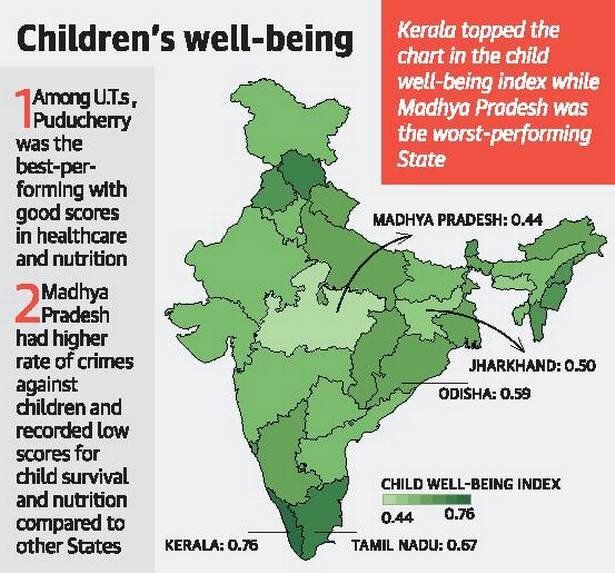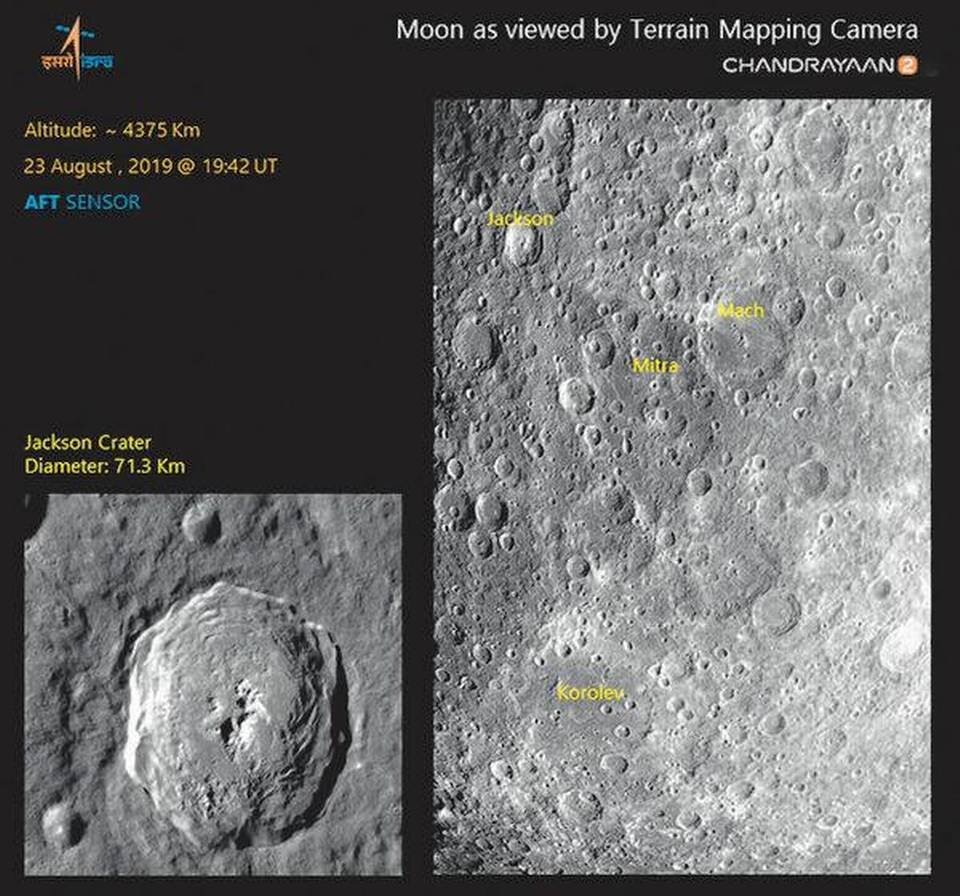Scheme to Screen Children for Leprosy & TB
The Union government has rolled out a scheme for universal screening of children below 18 years for leprosy and tuberculosis (TB).
- It is going to benefit almost 25 crore children and adolescents annually. This will help in ensuring timely screening for the diseases and will put them on treatment (if required).
- Rashtriya Bal Swasthya Karyakram (RBSK) Mobile Health teams will act as the delivery agent for the scheme. They will perform the screening of children for TB and Leprosy.
- Earlier, the screening of children of age group 0-6 years was done at Anganwadis and children of 6-18 years group were enrolled in government and government-aided schools.
- RBSK is aimed at early identification and intervention of diseases in children from their birth to 18 years of age so as to cover the 4 Ds—
- Defects at birth,
- Deficiencies,
- Diseases, &
- Developmental delays, including Disability.
Leprosy & TB burden in India
- India eliminated leprosy in 2005. All states except Chhattisgarh and the Union Territory of Dadra and Nagar Haveli have eliminated leprosy, but still, 1.15-1.2 lakh new leprosy cases are detected every year.
- Tuberculosis kills an estimated 4.8 lakh Indians every year and more than 1,400 every day.
- India has the highest TB burden in the world.
- More than a million missing cases are notified every year.
- Most such cases remain either undiagnosed, or are inadequately diagnosed, and are treated in the private sector.
Way Forward
- There is still stigma attached to leprosy, because of which authorities need to administer preventive medication to all the peer groups- family, parents, etc, very discreetly.
- Early detection and timely intervention will help in preventing disability and completely curing the disease.
Land Degradation
India is facing a severe problem of land degradation ie. soil becoming unfit for cultivation. About 29% or about 96.4 million hectares are considered degraded.
- To fight this menace, India will convert degraded land of nearly 50 lakh (5 million) hectares to fertile land in the next 10 years (between 2021 and 2030).
- 5 million hectares are part of the Bonn Challenge commitment.
- “Bonn Challenge” is a global effort to bring 150 million hectares of the world’s deforested and degraded land into restoration by 2020, and 350 million hectares by 2030.
- At the United Nations Framework Convention on Climate Change (UNFCCC) Conference of the Parties (COP) 2015 in Paris, India joined the voluntary Bonn Challenge and pledged to bring into restoration 13 million hectares of degraded and deforested land by 2020, and an additional 8 million hectares by 2030. India’s pledge is one of the largest in Asia.
- The government sees schemes such as the Pradhan Mantri Fasal Bima Yojana, Soil Health Card Scheme, and Pradhan Mantri Krishi Sinchayee Yojana as tools to tackle the problem of land degradation.
- Also, India, for the first time, will be hosting the 14th session of the Conference of Parties (COP-14) of the United Nations Convention to Combat Desertification (UNCCD) from 2nd-13th September 2019 in Greater Noida.
- The UNCCD was entered into force in December 1996. It is one of the three Rio Conventions along with United Nations Framework Convention on Climate Change (UNFCCC) and the Convention on Biological Diversity (CBD).
- India became a signatory to the UNCCD on 14th October 1994 and ratified it on 17th December 1996.
- The main objective of the convention is to combat desertification and mitigate the effects of drought in countries experiencing serious drought and/or desertification.
Janaushadhi Sugam
Recently, the Union Minister for Chemicals and Fertilizers has launched a mobile application called “Janaushadhi Sugam”, which will help people locate nearby Janaushadhikendras.
- Janaushadhi Sugam” mobile application would help people to:
- Locate nearby Janaushadhi Kendra (through Google Map).
- Search Janaushadhi generic medicines.
- Analyse product comparison of Generic vs Branded medicine in form of MRP & overall savings, etc.
- The app will augment the government vision to provide affordable healthcare to all Indians through the Pradhan Mantri Bhartiya Janaushadhi Pariyojana (PMBJP) Kendras across the country and this had already led to substantial savings to poor on medicines.
- The Minister also announced that “Jan Aushadhi Suvidha Oxo-Biodegradable Sanitary Napkin” will now be available at only One Rupee per pad.
- Jan Aushadhi Suvidha Oxo-Biodegradable Sanitary Napkin
- In a huge push for women hygiene, the government slashed the price of sanitary napkins sold from its Jan Aushadhi Kendras to Rs 1 per piece from Rs 2.50 earlier.
- According to the Ministry of State Chemicals & Fertilizers, about 28 million girls are reported to be leaving education because of lack of availability of good quality Sanitary Napkin” pads at a reasonable cost.
- This will ensure ‘Swachhta, Swasthya and Suvidha’ for the underprivileged women of the country
- These napkins biodegrade automatically when it comes in contact with oxygen after being discarded.
- These steps will help in fulfilling of vision of Affordable and Quality Healthcare for all and dream of Clean India & Green India.
India’s Child well-being Index Report
According to the recently released Child’s Well-Being Index Report, “Kerala, Tamil Nadu, Himachal Pradesh & Puducherry topped the charts, while Meghalaya, Jharkhand and Madhya Pradesh featured at the bottom.”
Child well-being Index Report
- The report is the collaborated work of a research institute IFMR LEAD & an NGO World Vision India.
- The NITI Aayog cited the report as crucial & significant in securing the rights of children and achieving the goal of child well-being, using a composite Child well-being Index.
- Child well-being Index is the tool to comprehensively measure & track children’s well-being.
- The index is computed on the basis of 3 dimensions (that include, healthy individual development, positive relationships, and protective contexts) & 24 indicators.
Insights from the Report
- The report provides insights on varied dimensions such as health, nutrition, education, sanitation, and child protection.
- It highlights the multi-dimensional approach to measure child well-being index. It goes beyond measuring income poverty & targets the holistic development of the children.
- One of the primary objectives of the report was to inspire academic and policy conversations on the under-researched theme of child well-being in India.
Way Forward
- Children are the future of our nation, if neglected, they will exacerbate the burden of poverty and inequality. So, the burden lies on the shoulders of all concerned stakeholders to prioritize and invest in the well-being of our children.
- States need to look at their respective scores on the dimensions of child well-being and need to prepare specific plans of action for priority areas of intervention.
- The report hopes to trigger policy level changes, seek better budgetary allocations and initiate discussions with all stakeholders, which can help in enhancing the quality of life of all children in the country.
- Some of the key indicators that need to be studied in the future include mobile usage, digital access, financial literacy, mental health and quality of relationships between parents/peers and children.
Revised Economic Capital Framework for RBI
Recently, the Reserve Bank of India (RBI) accepted the Bimal Jalan panel recommendations, set up to review the Reserve Bank of India’s (RBI’s) economic capital framework.
- Following these recommendations, RBI decided to transfer Rs 1.76 lakh crore in dividend and surplus reserves to the government.
- The objective of the economic capital framework is to build harmony between the central bank’s need for autonomy and the Government's objectives of the development.
- The Bimal Jalan-led panel recommended holistic risk capital frameworks to assess the adequacy of RBI reserves.
- Some recommendations of the committee:
- RBI to maintain the Contingency Risk Buffer (CRB), which is the country’s fund to handle financial stability within the range of 5.5% to 6.5% of the RBI’s balance sheet.
- It recommended a review of the Reserve Banks Economic Capital Framework (ECF) every five years.
- If there is a significant change in the RBI's risks and operating environment, an intermediate review may be considered.
- It also said the RBI's accounting year of July-June can be brought in sync with the fiscal year of April-March from the financial year 2020-21.
- It would also bring about a greater cohesiveness in the monetary policy projections and reports published by the RBI.
- The report has also removed the interim payout structure in general circumstances.
- The payment of an interim dividend may then be restricted to extraordinary circumstances.
- All the recommendations of the panel have been accepted by the RBI.
NOC online Application Processing System (NOAPS)
The Minister of State for Culture & Tourism has launched an integrated No Objection Certificate (NOC) online Application Processing System (NOPAS) for National Monuments Authority (NMA) for 517 local bodies of six states.
- NOAPS was launched by the NMA in September 2015 but was limited to only five urban local bodies in Delhi and one civic body in Mumbai.
- Now, the facility has been expanded to six more states: Madhya Pradesh, Andhra Pradesh, Haryana, Punjab, Jharkhand and Telangana.
- The online system automates the process of granting No-Objection Certificate (NOC) for construction-related work in the prohibited and regulated areas of the Archaeological Survey of India (ASI) protected monuments.
- NMA considers grant of permissions to applicants for construction-related activity in the prohibited and regulated area.
- National Monuments Authority (NMA) under the Ministry of Culture, has been set up as per provisions of the Ancient Monuments and Archaeological Sites and Remains AMASR (Amendment and Validation) Act, 2010.
- The applicant needs to fill up a single form which is being sent to the concerned agencies by the Urban Local Body, from whom No Objection Certificate (NOC) is required.
- The Portal has integration with the Smart ‘Smarac’ Mobile App of Indian Space Research Organization (ISRO), through which the applicant traverses his plot and the geo-coordinates of his plot along with the images get uploaded into the NIC portal along with the proximity and the approval status.
ASI Protected Monuments
- The Archaeological Survey of India (ASI), under the Ministry of Culture, is the premier organization for the archaeological researches and protection of the cultural heritage of the nation.
- ASI under the provisions of the AMASR Act, 1958 protects monuments, sites and remains of national importance by giving two months notice for inviting objections if any in this regard.
- The monuments and sites are maintained and preserved through various Circles of the ASI spread all over the country.
- There are at present more than 3650 ancient monuments and archaeological sites and remains of national importance.
Survey on Police
Recently, a survey conducted by Common Cause and Lokniti – Centre for the Study of Developing Societies (CSDS), has found police personnel to be under stress due to workload, poor work-life balance, and deficiency of resources.
Highlights of the Survey
- More than one-third of police personnel would be willing to give up their profession if they were given a chance to join another job with the same salaries and perks.
- Three in four personnel said the workload made it difficult for them to do their job well and was affecting their physical and mental health.
- An average police officer works for 14 hours a day, while the Model Police Act recommends an 8-hour duty.
- Every second police personnel reported not getting any weekly off day.
- Other than poor work-life balance, the police personnel also have to work with limited resources at their disposal.
- Some police stations lack basic facilities such as drinking water, clean toilets, transport, staff and funds for routine purchases.
- The police personnel also reported the absence of basic technological facilities such as computers and storage facility.
- The survey highlights the casual attitude of many in the police force towards judicial processes.
- About three in five police personnel believed that there should be a preliminary investigation done before registering a first investigation report (FIR), no matter how serious the reported crime is.
- This is in contradiction to a 2013 Supreme Court ruling which made it mandatory for the police to register an FIR if a victim discloses information about a cognisable offence.
- This contributes significantly to the police’s failure in developing a people-friendly image is its inability to perform one of its core functions i.e. register crimes.
- Every third police personnel surveyed agreed, for minor offences, a minor punishment handed down to the accused by the police was better than a legal trial.
- A three-fourths majority believed it was alright for the police to adopt a violent attitude towards criminals.
- The survey also found that a significant proportion of police force has a casual attitude towards mob violence.
- About three in five police personnel believed that there should be a preliminary investigation done before registering a first investigation report (FIR), no matter how serious the reported crime is.
- The survey also found that while the police personnel were sufficiently trained on physical parameters, weaponry and in crowd control, many lacked training on modules of new technology, cybercrime or forensic technology.
- This poor state of policing is reflected in India’s dismal ranking in the Rule of Law Index by the World Justice Project, wherein India ranked 68th out of 126 countries.
Way Forward
- Policing in India is becoming more and more difficult, in this context, there is the need for Police reforms. Since, Police, law and order are subjects of state list, the government can start from urging all the states to implement recommendations given by the supreme court in Prakash Singh case.
Chandrayaan-2 Scans Mitra Crater
Recently, the Chandrayaan-2’s orbiter has scanned a crater on the moon named after 20th century’s acclaimed radio physicist Sisir Kumar Mitra.
- The set of images taken by the Chandrayaan-2, also include the images of impact craters namely:
- Jackson: Named after a Scottish astronomer.
- Mach: Named after an Austrian physicist and philosopher.
- Korolev: Named after the father of the space programme of the erstwhile USSR.
- The Working Group for Planetary System Nomenclature of the International Astronomical Union (IAU)—the global authority for naming planetary features in the solar system— had named the impact based crater after Professor Sisir Kumar Mitra in 1970.
Sisir Kumar Mitra
- Sisir Kumar Mitra was an Indian physicist who led the research in the ionosphere– the upper region of the atmosphere–and radiophysics.
- He was the first to introduce the teaching of radio communication in India.
- His book, ‘Upper Atmosphere’ is considered as the Bible for research workers in the field of the ionosphere.
- In the 1950s, he advocated space research and high altitude rocket research programmes which had been successfully conducted by the US and USSR.
Lunar Craters
- Lunar Craters are bowl-shaped landforms created by Volcanism and Cratering.
- There are hundreds of thousands of moon craters ranging from less than a mile across to giant basins.
- The largest crater on the Moon is called South Pole-Aitken Basin.
- Moon’s lack of water, atmosphere, and tectonic plates, there is little erosion, and craters are found that exceed two billion years in age.
Chandrayaan-2
- It will attempt to soft-land the lander -Vikram and rover- Pragyan in a high plain between two craters, Manzinus C and Simpelius N.
- It is the first Space Mission to conduct a soft landing on the Moon's south polar region.
- It is the First Indian expedition to attempt a soft landing on the lunar surface with home-grown technology.
- India is the fourth country ever to soft-land on the lunar surface.
Tech-Saksham
The Union Minister for Micro, Small and Medium Enterprises (MSME) has launched a project named ‘Tech Saksham’ to accelerate MSME growth through technology enablement.
- It is a Ministry of MSME and Confederation of Indian Industry (CII) partnered project which brings together technology majors Dell Technologies India, HP India, etc to address technological gaps faced by MSMEs in their growth.
- Vision: To bridge the gap in technology adoption for MSMEs so as to provide an impetus for them to be competitive on a global scale, increase their contribution to country exports and leverage cost efficiencies.
- Duration: It is a three-year-long comprehensive project which, in its first phase, will focus on sectors that are labour-intensive and have the propensity to respond positively to tech-adoption, and will spark a larger discussion in other MSME clusters.
- Expected Outcome: Through various policy recommendations, knowledge sessions, mentoring initiatives, and useful resource banks for MSMEs, the project will help in addressing critical barriers in the MSME ecosystem such as awareness and cost of technology purchase/maintenance, resources and manpower required to run the technologies, return on investments, etc.
Rare Tarantula Sighted in Tamil Nadu
The spider belonging to the Genus Poecilotheria, commonly known as the Peacock Parachute Spider or Gooty Tarantula was spotted in the Pakkamalai Reserve Forests in Villupuram District,Tamil Nadu.
- Peacock Parachute Spider (Gooty Tarantula)

- The International Union for Conservation of Nature (IUCN) has categorised it as Critically Endangered.
- It is endemic to India.
- The known habitat of this species is in the Eastern Ghats especially degraded forests near Nandyal in Andhra Pradesh.
- Species of this genus can be identified based on the banding patterns on the underside of the legs.
- Tarantulas are biological pest controllers and there is a huge demand for them by collectors in the pet trade. There is an urgent need to protect them.


